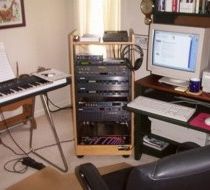|
|
|
|
If you've come to this page, more than likely you're curious about MIDI (MIDI is an acronym for the Musical Instrument Digital Interface standard). If not, there's lots of web site pages that provide tutorial information, so I won't repeat it here. In brief, MIDI requires special hardware and software. Both the musical instrument and computer equipment must have both. In general, these devices pass data messages back and forth, specifying notes to turn on (or off), the pitch of the note, the duration of the note, and the instrument sound to be used for each particular note. There's also messages for sustain pedals, pitch wheels, reverb effects and much more. If you want to learn more about MIDI, you can type "MIDI" into any search engine and get several million pages to visit, or you can click on this link: A Beginner's Guide to MIDI |
|
| |
|
|
|
|
The MIDI files provided below are all GM (General MIDI) files, which will play on a computer or sound module that is GM compatible. As a result, these files are pretty simple and are subject to limitations, like a standard set of 163 instrument patches, the use of just one MIDI unit, and the production of 16 simultaneous instrument sounds. The MIDI files I use at home employs a computer interface that enables access to thousands of instrument patches, the simultaneous use of 8 MIDI sound modules (resulting in 128 simultaneous instruments). The rack of equipment in the photo at right contains half my sound modules, an eight-channel mixer, and 2 effects processors. Additional equipment (not shown) includes 5 more sound modules, amplifiers, speakers, recording equipment, boxes of cables and more. |
 |
|
| |
|
|
|
While GM files can produce a decent "band" sound, they won't produce a real good "orchestra" sound or even a decent "live" sound. To begin with, the sound resulting from GM Midi is totally dependent upon the quality of equipment at the receiving end, which can be different than the way it sounds at the originating end. Most GM compatible sound modules will perform well, but computer generated sounds can vary greatly. To avoid dependence on an unknown device, I usually convert the MIDI files to WAV files. But even that has its limits because playing a WAV file on a computer with its audio line out connected to amplified 3-way speaker system will sound a whole lot better than the sound produced by the internal speaker on a laptop or cell phone.
Examples of recent fun projects can be found on the Recent BIAB Arrangements page. Another project (converted to an .mp4 file to include photos) is "It's the Gift", as noted on the 1941 Dodge Pickup page. That's a special tribute to my three sons for surprising me with that 1941 Dodge Pickup.
To play the simple GM MIDI files below, click on any song title and a jukebox will appear. You can interrupt a song at any time by selecting a new one, by "pausing" the player that appears, or by closing the jukebox window. I have well over a thousand MIDI files in my collection.
Some of the old 50's and 60's songs are listed below. |
|
|
|
|
|